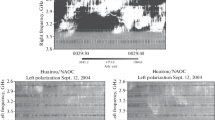Abstract
Various mechanisms for generating coherent curvature radiation have been proposed1 to explain the high brightness temperature of pulsars at radio frequencies. The bunching of counterstreaming charged particles2–5, although requiring rather special conditions and subject to criticism6, has hitherto seemed the most plausible. Here we propose an entirely new mechanism of ‘burst emission’, which initiates at the surface of a neutron star and occurs naturally without any need to postulate special conditions. We argue that the induced electric field in the near magnetosphere of a rotating neutron star is sufficiently strong to detach moderately large grains of solid matter from the surface in the polar-cap regions. The detached grains erupt and form ascending plumes or jets of dense and highly charged gas. These thread-like plumes, of length h ≳ 102 cm, then accelerate along the open magnetic field lines and emit intense partially coherent radiation, at radio frequencies, with a low-frequency cutoff at c/h. Our estimates indicate that burst emission can account for the principal characteristics of the observed radiation from pulsars at radio frequencies.
Similar content being viewed by others
References
Manchester, R. N. & Taylor, R. N. Pulsars (Freeman, San Francisco, 1977).
Sturrock, P. A. Astrophys. J. 164, 529–556 (1971).
Goldreich, P. & Keeley, D. A. Astrophys. J. 170, 463–477 (1971).
Tademaru, E. Astrophys, Space sci. 193, 193–203 (1971).
Ruderman, M. A. & Sutherland, P. G. Astrophys. J. 196, 51–72 (1975).
Ginzburg, V. L. & Zheleznyakov, V. V. Comments Astrophys. Space Phys. 2, 167–171 (1970).
Chen, H. H., Ruderman, M. A. & Sutherland, P. G. Astrophys. J. 191, 473–477 (1974).
Flowers, E. G. et al. Astrophys. J. 215, 291–301 (1977).
Michel, F. C. Astrophys. J. Lett. 195, L69–L71 (1975).
Cheng, A. F. & Ruderman, M. A. Astrophys. J. 212, 800–806 (1977).
Hayden, H. W., Moffett, W. G. & Wulff, J. The Structure and Properties of Materials Vol.3 (Wiley New York, 1965).
Sieber, W. Astr. Astrophys. 28, 237–252 (1973).
Cordes, J. M. Astrophys. J. 208, 944–954 (1975).
Author information
Authors and Affiliations
Rights and permissions
About this article
Cite this article
Harrison, E., Tademaru, E. & Greenstein, G. A burst emission mechanism for coherent radiation from pulsars. Nature 308, 826–828 (1984). https://doi.org/10.1038/308826a0
Received:
Accepted:
Issue Date:
DOI: https://doi.org/10.1038/308826a0
- Springer Nature Limited





